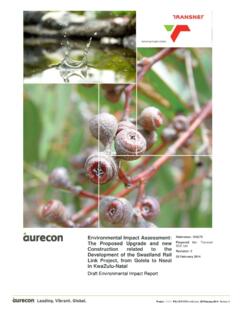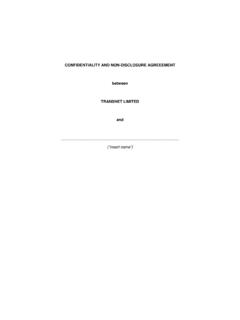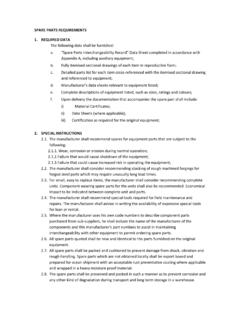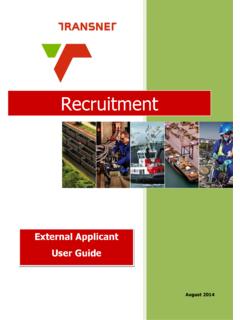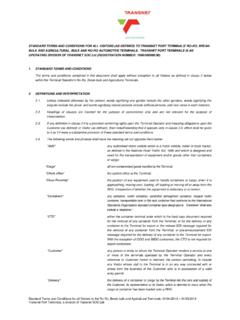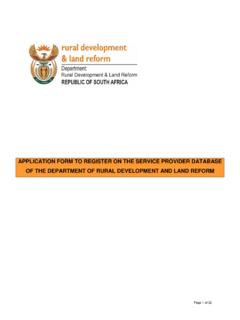Transcription of ANNEXURE A GUIDLINES FOR COMPLETION OF …
1 1 ANNEXURE A GUIDLINES FOR COMPLETION OF supplier development (SD) PROPOSAL What is supplier development ? Definition The supplier development (SD) Programme is a department of Public Enterprises (DPE) initiative supported by Transnet. The aim of SD is to increase the competitiveness, capacity and capability of the South African supply base where there are comparative advantages and potential competitive advantages of local supply. This can be achieved through skills transfer, increasing the local content of items procured, as well as building new capability in the local supplier base. In addition, SD has its roots grounded firmly around the transformation of South Africa and the empowerment of previously disadvantaged individuals and enterprises.
2 Background and Guidance on the of supplier development Objectives for South Africa As a developing economy with inherent structural and social imbalances, South Africa is facing the significant economic challenge of increasing growth in a manner that includes all South Africans. The historical lack of investment in infrastructure in South Africa has had significant negative impacts on local industry, resulting in a loss of key skills and a decrease in manufacturing industry capabilities. To respond to this, Government policies have been designed to address these imbalances and to act as a catalyst of change for the benefit of South Africa. One of these Government policies, the New Growth Path (NGP) aims to enhance growth, employment creation and equity by reducing the dependencies of South African industries on imports, and promoting the development of skills and capabilities that are in short supply within the country.
3 It identifies strategies that will enable South Africa to grow in a more equitable and inclusive manner and promotes the development of new industry to attain South Africa s developmental agenda. Transnet s SD is closely aligned to the NGP objectives and as a result is able to fulfil its commitment to sustainability within South Africa whilst at the same time addressing other corporate objectives including 2 increasing productivity and efficiency, volume growth, capital investment, financial stability, funding, human capital, SHEQ1, regulatory and improving customer service. The combined objectives of Transnet and Government can be realised through: Aggressively implementing capital investment plans which will result in competitive local industries; Improving operational efficiency; Using procurement to influence the development of the local supplier industry; and Ensuring it creates sufficient opportunities for the participation of previously disadvantaged groups in the economy.
4 This will lead to Transnet achieving its long-term objective of increasing both shareholder and societal value using its procurement expenditure to ensure local development through sustainable localisation of its supply chain and the inclusion of the previously disadvantaged individuals in the economy in a manner that is beneficial to Transnet, South African industry, and the population of South Africa. As a result the State Owned Enterprise (SOE) is able to fulfil its responsibility as the biggest player in the South African freight logistics chain whilst complementing the objectives of Government. Transnet s supplier development objectives and framework To aid its implementation of SD, Transnet has adapted an existing framework from the DPE.
5 This framework allows for a basic set of principles to be applied to appropriately target SD initiatives. supplier development initiatives aim to build local suppliers that are competitive through building capability and capacity. Hence the framework has been termed the Increased Competitiveness, Capability and Capacity (IC3) supplier development Classification Matrix. The framework encapsulates the types of SD opportunities which Transnet currently considers and allows Transnet to move its SD structure away from a dynamic policy environment towards a framework that is designed around general supplier development objectives. This allows Transnet to adopt a standard structure but also allows the flexibility to change emphasis on certain aspects as objectives change.
6 The 1 SHEQ - Acronym for Safety, Health, Environment and Quality 3 IC3 Matrix (refer to Figure 1) categorises SD opportunities on a matrix based on their value, extent of industrial leverage and strategic importance to Transnet. Further categorisation of opportunities into the relevant quadrants is based on supplier -buyer power, industrial complexity, risk and the length of procurement period. Value Leverage refers to transactions where the financial scale of the transaction allows the buyer the opportunity to negotiate supplier developmentIndustrial Leverage refers to transactions whereby the nature of the procurement is such that the scale and the industrial complexity of the item being purchased allows for local supply chain development around a particular industryStrategic Importance to Transnet refers to the extent to which the product to be procured has a impact on Transnet s core businessValue leverageHighLowHighLowFocusedSmall Enterprise DevelopmentProgrammaticStrategicIndustri al leverageStrategic Importance to TransnetIndustrialisationLocalisation and supplier
7 DevelopmentSkillsDevelopmentTo ease implementation of SD within Transnet, a framework to encompass all types of SD opportunities was developed by the DPETheIC3supplier development classification matrix assists in categorising opportunities according to their industrial leverage, value leverage and strategic importance to TransnetOnce opportunities are identified it will be possible to identify the policy/procedural tools that should be implemented to maximise the full supplier development potential from the opportunitiesIC3 supplier development Classification MatrixNot currently a focus area Figure 1: The IC3 supplier development Classification Matrix In order for suppliers to successfully meet the needs of a particular initiative, a detailed understanding of each quadrant is required.
8 Programmatic Programmatic initiatives follow a longer than normal planning horizon and generally exceed the funding capacity of Transnet s balance sheet. They are identified either in the Industrial Policy Action Plan II (IPAP II) or through the SOE as a strategic fleet. Collaboration between the SOE and Government is achieved 4 through focused task teams whereby infrastructure development and industrialisation is achieved through joint support and in some cases public spending. Investment is focused in plant, technology and skills in both intermediate and advanced capabilities to develop competitive advantage. Strategic Strategic initiatives follow a three to five year planning horizon, involving investment in at least plant, technology and/or skills in intermediate capabilities.
9 This enforces the need for multinational corporations and Original Equipment Manufacturers (OEMs) to develop a certain percentage of their products locally. Strategic initiatives can therefore be used to achieve localisation objectives by increasing the competitiveness, capability and efficiency of local suppliers. Strategic initiatives can sometimes focus on advanced capabilities but will in most cases require government support to develop local capability. Focused Focused initiatives include all high value transactions with limited industrial leverage and medium to low strategic importance. These initiatives address shortto medium-term contracts that can be leveraged to encourage supplier development , with a focus on investment in technology or skills that enhance existing local capability.
10 Emphasis will largely be placed on benefiting previously disadvantaged individuals. The overall result improves the socio-economic environment by creating competitive local suppliers and furthers objectives of empowerment, transformation and regional development . Small Enterprise development Small Enterprise development initiatives are typically of low value and have no industrial leverage as they are characterised by typically low complexity goods and high competition. These initiatives concentrate on increasing the capability of small local suppliers and are targeted toward historically disadvantaged individuals and communities, providing basic skills development and improving local employment and quality job creation.

